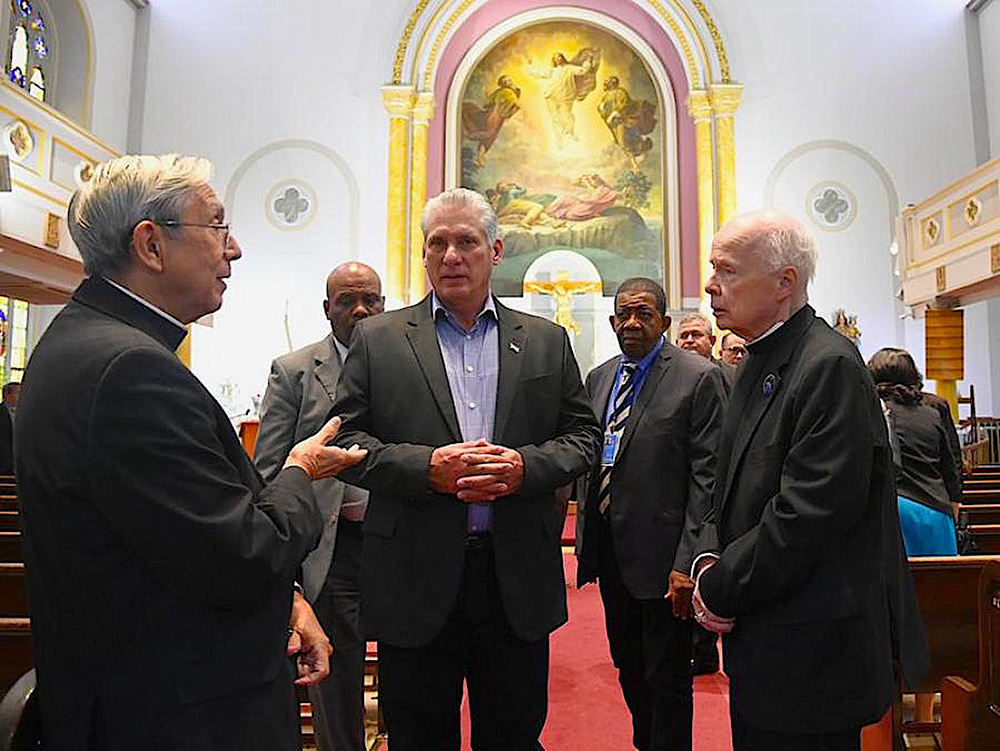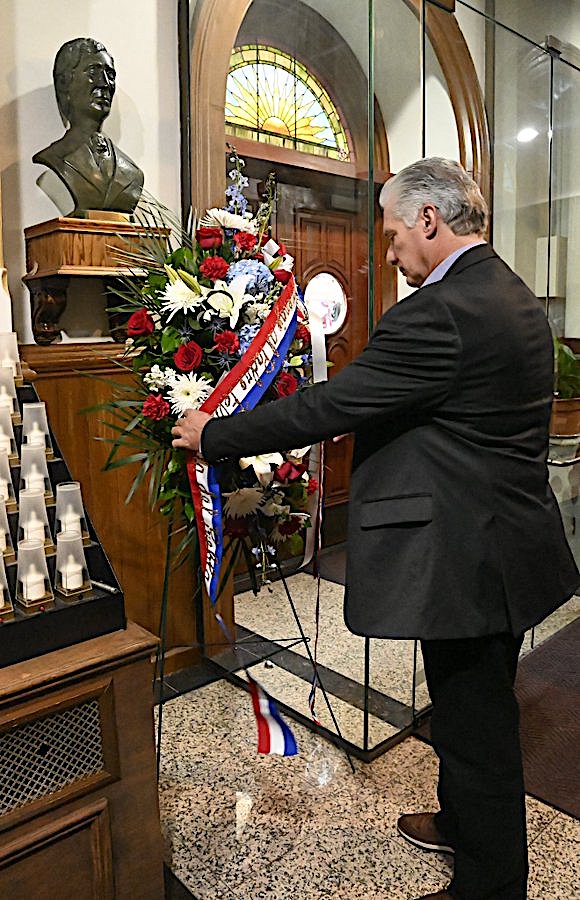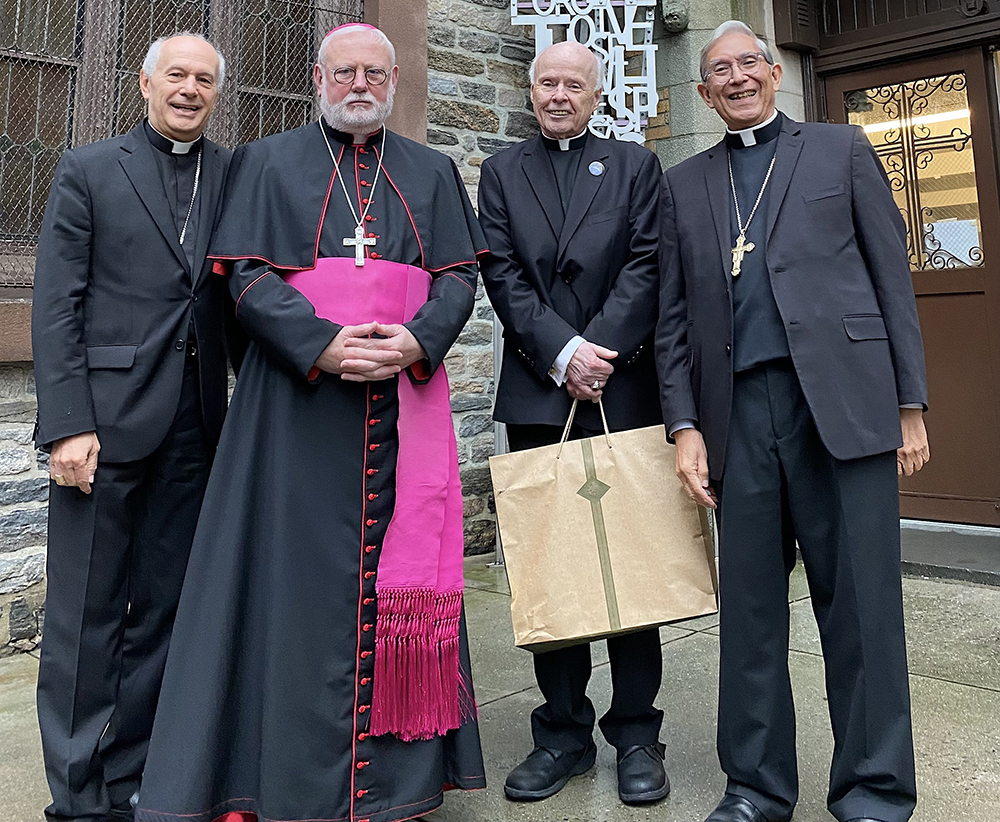
CHINATOWN — Father Félix Varela — the Cuban exile who 200 years ago landed in Manhattan to serve marginalized immigrants — received honors on Sept. 23 from the man who leads the national government and communist party of Cuba.
The venue was the historic Catholic Church of the Transfiguration, founded in 1836 by Father Varela, who is a candidate for sainthood. There, President Miguel Díaz-Canel y Bermúdez placed flowers at the bust sculpture of Father Varela inside the church.
The humble priest (1788-1853) is considered “venerable ” for his dogged missionary work on behalf of impoverished newcomers to America.
But in his native country, Father Varela is revered as a revolutionary leader for independence from the monarchy of Spain. In Cuba, he is frequently referred to as “the one who taught us to think.”
The Cuban government does not acknowledge Father Varela’s saintly ministry, said retired Auxiliary Bishop Octavio Cisneros of Brooklyn, who attended the president’s visit at Transfiguration.
“But here he becomes one of the great, holy priests dedicated to the poor, the hungry, and the forgotten — most of them, Europeans, and the great majority, Irish.”
Bishop Cisneros is a native of Cuba who left the country as a boy following the communist takeover in the 1960s. He is a longtime devotee of Father Varela and vice-postulator of the cause for his sainthood.
Díaz-Canel had been in Manhattan since Sept. 17 for a week of meetings at the 78th United Nations General Assembly. He delivered a speech at the U.N. two days later, the same day as President Joe Biden.
Security was tight in rainy Chinatown during the Cuban president’s visit to the church. Secret Service agents and NYPD officers waited until after he left to allow reporters from The Tablet and Currents News into the church.
Although the president’s visit was brief, he commemorated it with a post on social media: “At the Church of the Transfiguration, in New York, we honor Father Félix Varela, who arrived in this city 200 years ago. ‘He who first taught us to think’ wanted Cuba to be as much an island politically as it was in nature and to owe its independence only to its children.”

During his speech at the General Assembly, the president cited the communist leader Che Guevara to affirm the “exploited and the humiliated.”
In a 2021 interview with The Tablet, Bishop Cisneros commented on the iconic portrait of Guevara, often recreated in popular culture. Conversely, Bishop Cisneros said the image reminded him of “the devil.”
He then recounted how Guevara carried out the strong-arm directives of the late dictator Fidel Castro. After the revolution of 1959, they chased nearly 75% of the Catholic clergy from Cuba. Bishop Cisneros was born there in 1945.
Still, the president’s visit to Transfiguration was cordial. Bishop Cisneros said the president asked for the visit, and Cardinal Timothy Dolan obliged.
Cardinal Dolan was enroute to the visit, but before he could arrive, the president departed early.
“I took it upon myself to greet the president and welcome him to the church,” Bishop Cisneros said. “We never say no to anyone who would come to a church. So, I tried to explain to him a little bit about what this church is all about — this parish.”
Father Varela was appointed to represent Cuba on the governmental body in Spain, but his advocacy for independence for Latin America and an end to slavery rankled the crown and made him a marked man.
The priest fled his post in Spain and became exiled, never to see Cuba again. That much the president surely knew, Bishop Cisneros said.
He described telling the president how Father Varela instituted multiple programs to ease the crowded, disease-ridden squalor of 19th-century lower Manhattan.
An anti-Catholic mentality prevailed then, which made his work that much harder. Still he prevailed, visiting the cholera patients in hospitals, and especially helping women acquire job skills and work to avoid becoming prostitutes.

Father Varela became ill and retired to St. Augustine, Florida, where he died at age 64 in 1853. Pope Benedict XVI named him “venerable” in 2012. The next step is beatification, pending a miracle attributed to him.
Bishop Cisneros said he had no idea if the president would remember anything about Father Varela’s New York ministry, or if he would care to share it back in Cuba.
“What is in his heart? God knows,” Bishop Cisneros said. “I hope there is somehow the grace of God touching him. Because there is still a lot to be done in Cuba. A lot of young men are prisoners for political reasons.
“But Varela was about truth and freedom. What Catholic priests cannot preach that?”

Father Varela and his church were allowed to be used by an atheistic, evil regime for a glorified photo-op for PR purposes. In other words, the Castro people (and yes, it’s still a Castro who’s calling the shots in Cuba) were simply given what they wanted as if they’d ordered a pizza for delivery. Did Cardinal Dolan even consider what Cubans would think of this contrived event catering to a horrific totalitarian dictatorship? Did it even occur to him that this would scandalize Cubans, especially Cuban Catholics, when Christ expressly forbade such scandal? As for Bishop Cisneros, he seems to be living in some cloud, and he would have done much better to heed Christ’s injunction to be as shrewd as serpents–particularly when dealing with poisonous snakes. In case it’s still not clear, this event was profoundly offensive to Cubans, who want their country rid of the communist cancer which has destroyed their homeland–in a word, this was an abomination.
Another great article by Mr. Bill Miller!